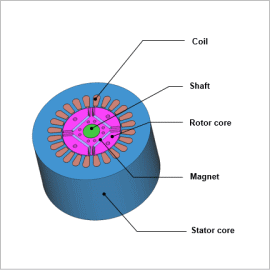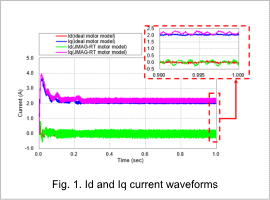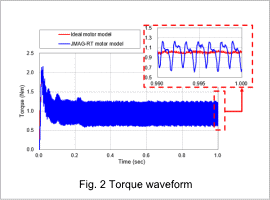*Please prepare a license ID and password for the license administrator.
*It is different from the service for JMAG WEB MEMBER (free membership). Please be careful.
Overview

Traditionally, the design of a motor’s controls and the design of the motor itself were often performed independently because coordinated designs were difficult to carry out. Motor control designs have been getting more advanced, however, so there has been an increasing demand for simulations that use detailed motor models that exhibit behavior that conforms to that of an actual machine.
With JMAG, it is possible to create a detailed model that conforms to a real machine and accounts for spatial harmonics and magnetic saturation characteristics that are included in a motor. Importing this motor model, a “JMAG-RT model,” to a control/circuit simulator makes it possible to carry out a linked simulation that accounts for a motor’s magnetic saturation and spatial harmonics as well as a motor drive’s control characteristics.
The purpose of this Application Note is to demonstrate how to import a JMAG-RT model to a control/circuit simulator after using the JMAG-RT to obtain the inductance spatial harmonics of the torque and coil. The model is then used to run an analysis that controls the speed of an IPM motor to its target value.
With JMAG, it is possible to create a detailed model that conforms to a real machine and accounts for spatial harmonics and magnetic saturation characteristics that are included in a motor. Importing this motor model, a “JMAG-RT model,” to a control/circuit simulator makes it possible to carry out a linked simulation that accounts for a motor’s magnetic saturation and spatial harmonics as well as a motor drive’s control characteristics.
The purpose of this Application Note is to demonstrate how to import a JMAG-RT model to a control/circuit simulator after using the JMAG-RT to obtain the inductance spatial harmonics of the torque and coil. The model is then used to run an analysis that controls the speed of an IPM motor to its target value.
Id and Iq Current Waveforms / Torque Waveform
Fig. 1 shows the Id and Iq current waveforms from the vector control analysis, and fig. 2 shows the torque waveform. The JMAG-RT motor model accounts for the motor’s geometry, so it is possible to display the current and torque waveforms, inducing the slot harmonic components. However, the ideal motor model does not include slot harmonic components. The evaluation for the q-axis current is also smaller than with the JMAG-RT motor model.




